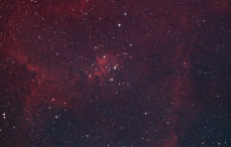So you’ve gotten through the Milky Way objects in Sagittarius and they’ve have started to fade off to the West. After that marathon, you might be wondering where to go next. Don’t worry, so many great objects are in prime spots, or are coming up!
August
In the Northeast, from top to bottom just after dark are The Elephant’s Trunk, Wizard, Bubble, Heart and Soul nebulae. These objects traverse the same patch of sky, which keeps my camera exposing from dusk till dawn through a window in my backyard trees. I get about 2 hours on 4-5 objects each every clear night. Through many late nights in July, I collected 8 total hours on the Wizard and 5 hours of Ha data on the Elephant’s Trunk. As I move through August I’m moving down the line. After getting some decent RGB data on the Elephant’s trunk, I’ll move onto the Bubble Nebula & M52, the Veil complex and then the Heart. These objects are all relatively dim and will require many long exposures of 5+ minutes each and 5-7 hours of integration time. The only image of the following I would say that I’m done with (for now) is the Wizard. The others require a few more clear nights.
September
So let’s say it’s the last week of August. I’ve completed what I need for the Elephant’s Trunk, Bubble and Veil. Where do I go now after dusk? The king of galaxies is getting higher in the sky. Andromeda is huge and bright, rising high in the East in late August and Early September. You’ll only need 2-3 minute exposures at most on M31, but take A LOT. There is so much detail to be collected in this large galaxy that’s relatively close to us. Catching the details and blue colors in the outer bands requires a lot of integration time. You can get quick results, but complete result will consist of several hours of integration time. Take your time to get a minimum of 3 hours on M31 – more if you’re in a light polluted area.
Speaking of the blues, I recommend going with an L-Pro, or IDAS D-1 style filter for M31 rather than a CLS filter if your light pollution allows. The L-Pro doesn’t cut out as much of the spectrum and in a Bortle 8/9 area, the images will wash out quickly. You can process to bring out some of the blue when using a CLS filter, but it won’t be pronounced, and it is very difficult to balance the rest of the image. I recommend an L-Pro style filter for ALL galaxy imaging. If you’re in a light polluted areas, your subs will need to be shorter using a wider spectrum filter to avoid overexposing the image, and you’ll need to increase the number of subs.
M33, the Triangulum Galaxy, trails behind Andromeda in the sky following nearly the same path, and it’s nearly all blue. M33 is an amazingly detailed galaxy that requires many hours to capture. Plan on 7+ hours from a light polluted location.
M33 below was taken with a CLS filter before I had an L-Pro, and Andromeda was taken with no filter at a dark site. M33 took a significant amount of processing to bring out the blues and is only about 1/2 the amount of exposure time I need for it. Unfortunately the M31 example was taken the first night I started imaging, so it lacks the necessary time to make a complete image.
By the time M33 gets up to the zenith shortly after dusk, you’ll be turning your sites to all of the treasures in and around the constellation Orion – The Witch Head, Horsehead and Flame, Barnards Loop if you’re doing lens work, Rosette, Cone nebula and Christmas Tree Cluster, and of course, the grand daddy of them all, M42, the Great Nebula in Orion. You can spend an entire Fall and Winter just in and around Orion, and I recommend you do if you’re just starting out. Its a great area of the sky with varied objects to learn on.

Have fun this fall and take your time. If you don’t get to an object before it hides behind a tree or a roof, don’t worry, I promise it’ll be back next year.
Clear Skies, Bleary Eyes – KA






